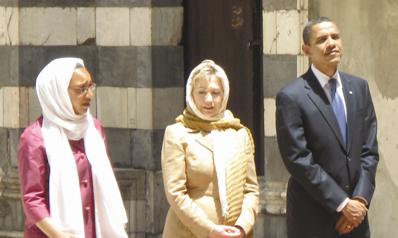| |
| |
UNFORGETTABLE TOUR |
| |
Alumna guides Obama on
Sultan Hassan mosque tour |

During the U.S. presidential campaigns, Iman Abdulfattah (MA ’04), who works as an Islamic art historian at Egypt’s Supreme Council of Antiquities, was sitting with one of her friends talking about the elections. “Imagine Barack Obama is elected president,” she speculated. “Imagine he comes to Cairo and I take him to my favorite monument –– the Mosque-Madrasa of Sultan Hassan.”
Abdulfattah, who grew up in New York and was born to an American father and Egyptian mother, found her dream becoming a reality in June, when President Obama came to Egypt to deliver his long-awaited speech to the Muslim world. Surely enough, before the speech, he toured the Mosque-Madrasa of Sultan Hassan with U.S. Secretary of State Hillary Clinton, and Abdulfattah was there guiding them around this historic Islamic monument.
Abdulfattah is not new to this. She has taken dignitaries and heads of state on tours before, including the presidents of Ghana and Serbia, the queen of Norway and the princess of Thailand. But this tour was special. Not only had Abdulfattah voted for Obama, but to her, he represented the American dream. “Obama achieved something that is unprecedented,” Abdulfattah explained. “His physical manifestation, cultural background and mixed roots are things many Americans, including myself, can relate to. For me to be entrusted to take this president –– not just any U.S. president –– on a tour preceding a speech that was highly anticipated around the world was very rewarding. No monetary incentive can ever equal the gratification I got.”
On the day of the visit, Abdulfattah was extremely nervous, but it was President Obama who made her feel at ease. “He introduced me to every single member of his staff by name –– a gesture that I hadn’t seen before from other heads of state. He asked me where I was from, where I studied and sometimes joked to break the ice. He was genuinely interested and receptive, very elegant and confident,” she said.
Obama and Clinton were well prepared. They had read up on the 14th century mosque, which also served as a communal school, hospital and dormitory, and its founder Sultan Hassan and were able to intertwine historical facts with the information provided to them. They also paid attention to the details. “At one point, President Obama asked about a Kufic Quranic inscription carved around the qibla iwan, saying that it is different from the type of Arabic he sees today,” noted Abdulfattah. “I explained that the Kufic style of writing is archaic and angular, whereas what he is more familiar with is a cursive style of writing.” Other features that caught their attention were the open courtyard, which provided access to ancillary parts of the monument, and the types of stones used as decorative elements in the mosque.
Abdulfattah’s interest in Islamic art and architecture developed at an early age. Every summer, she would travel with her mother to Egypt and other Middle Eastern countries like Morocco, Syria and Turkey, visiting historic sites. In 1994, she came to AUC as a study-abroad student. “An introductory course on the art and architecture of Cairo had a particular impact on me,” she said. “We went on a series of field trips, and through my academic studies, I was able to understand the relation between monuments and the history of the city. That course really grounded me.”
Abdulfattah earned her bachelor’s in Near Eastern studies and literature from New York University and her master’s in Islamic art and architecture from AUC. After working for U.S.-based nonprofit and educational organizations for several years, she came to Egypt in 2005 to work as an Islamic art historian at the Supreme Council of Antiquities, where she is involved with a number of museum and heritage projects. Her recent duties have included coordinating the renovation of the Museum of Islamic Art and taking part in the scientific development of the planned Museum of Historic Cairo.
By Dalia Al Nimr |